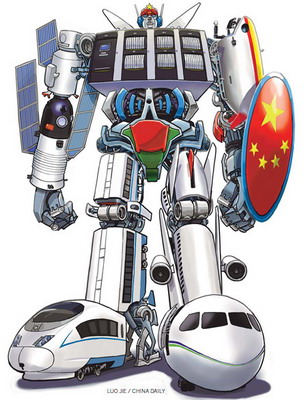China wows world with engineering
 |
China surprised the world with its engineering and technical feats in 2010, when it completed several monumental projects high in the sky, deep in the seas and in-between.
China last year completed 15 successful space launches, including that of its second lunar probe, Chang'e-2, which will determine a site for the country's first unmanned moon landing around 2013.
The Long March launch vehicles also sent five Beidou navigation satellites into orbit. The launches were part of the country's plan to have 12 Beidou navigation satellites form a network covering the Asia-Pacific region before 2012. The system will have 35 navigation satellites by 2020, when it will rival the United States' Global Positioning System.
On the ground, China became a strong player in the global high-speed railway industry in 2010 by innovating upon technologies previously imported from Germany, France and Japan.
The Ministry of Railways announced the nation's high-speed railway network last year reached 7,531 km, becoming longer than any other countries'.
The network's top service speed became the world's fastest at 380 kilometers an hour since the Shanghai-Hangzhou high-speed railway opened in October.
It set new operation speed records twice in 2010.
In September, a China-made fast train reached 416.6 km an hour on the Shanghai-Hangzhou high-speed railway. Two months later, a train on the 1,318-km-long Beijing-Shanghai high-speed railway beat that record by reaching 486.1 km an hour.
Sources with CSR Corp Ltd, a major domestic train manufacturer, said in December that an experimental train is being developed that would challenge the 574.8 km an hour speed traveled by a specially configured version of France's TGV in 2007.
The country also made great achievements in the deep sea, becoming the fifth country to develop deep-diving technology capable of going beyond the 3,500-meter mark.
The domestically developed submersible Jiaolong planted a Chinese flag on the bottom of the South China Sea during a 3,759-meter-deep dive in July.
The vessel, designed to reach a depth of 7,000 meters and operate in most of the planet's oceans, is considered the world's only manned submersible that can theoretically reach those depths. Japan's Shinkai 6500 can dive for 6,500 meters. The other three countries with deep-diving technology are the United States, France and Russia.
And 2010 was the year China overtook the United States in developing the fastest supercomputer.
The Tianhe-1A can perform 2,507 trillion calculations a second and is 29 million times faster than the earliest supercomputers.
In addition, the water level of the largest hydroelectric project, the Three Gorges Dam, had increased to 175 meters as of October 2010, enabling it to generate electricity at maximum capacity.
The slew of mega-projects were made possible by the country's mammoth spending on research and development.
According to the Paris-based Organization for Economic Cooperation and Development (OECD), China's investment in innovation nearly doubled from 34 billion euros ($44.56 billion) in 2006 to 65.7 billion euros in 2009.
The country's spending on innovation is now growing at 25.5 percent a year, compared to a fall of 4 percent in the US in 2009. Growth in major European economies, such as Germany and France, has remained in the single figures.
Even greater sums have been poured into infrastructure development. An estimated 700 billion yuan ($105 billion) was the budget for high-speed railway construction in 2010, Ministry of Railways Chief Engineer He Huawu said.
But the breakthroughs are not merely the result of increased funding.
China has over the past few years transformed from a country that imported technologies to one that leads in innovation. It is now competing for overseas high-speed railway projects - even in the US, which leads the world in freight railway technology but has almost no high-speed rail expertise.
"That's a mark of how well and quickly the technology has been adopted by Chinese companies, who have traditionally only been able to compete on price in bidding for railway and other basic infrastructure projects in the developing world," the Associated Press reported.
The Ministry of Railways started out with the strategy of "innovating on the basis of imported technologies to form our own system", He, with the ministry, had said earlier.
The ministry had filed 947 patent applications in the country by March 2010 and had also started filing applications for intellectual property rights abroad.
Wang Mengshu, professor at the Research Center of Tunnel and Underground Engineering at Beijing Jiaotong University and a member of the Chinese Academy of Engineering, believed: "China has the most advanced high-speed railway technology."
The ministry's plans called for the country's railways to extend for more than 120,000 km by 2020. About 16,000 km will come from new high-speed rail construction.
China has launched three manned spaceships and two unmanned lunar orbiters in recent years. It aims to build a space station by 2020, and will launch two spacecraft - Tiangong-1 and Shenzhou VIII - in 2011 to test its docking technology.
Sun Jiadong, the Beidou program's chief designer, said in an earlier interview: "The rise of China as a big economy and the advancement of technology have laid the foundation for us to pursue progress in aerospace technology... It is important to find our own exploration path based on China's own situation."
 0
0 







Go to Forum >>0 Comments